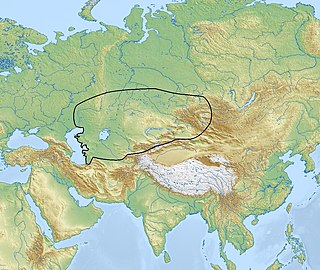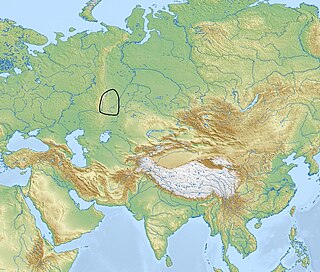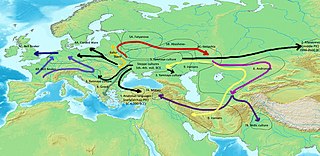Gallery
- Gold jewellery, c. 1600-1400 BC
| Geographical range | Romania, Moldova |
|---|---|
| Period | Bronze Age |
| Dates | c. 2000 BC - 14th century BC |
| Preceded by | Glina-Schneckenberg culture |
| Followed by | Noua-Sabatinovka culture |
The Monteoru culture was a Bronze Age archaeological culture located in Romania and Moldova, dating from c. 2000 BC to the 14th century BC. It was derived from the preceding Glina-Schneckenberg culture and succeeded by the Noua-Sabatinovka culture, and was contemporary with the related Tei culture. [1] [2] [3] [4]
According to Anthony (2007), chariotry spread westwards to the Monteoru culture from the Multi-cordoned ware culture. [5]

The Bell Beaker culture, also known as the Bell Beaker complex or Bell Beaker phenomenon, is an archaeological culture named after the inverted-bell beaker drinking vessel used at the very beginning of the European Bronze Age. Arising from around 2800 BC, it lasted in Britain until as late as 1800 BC but in continental Europe only until 2300 BC, when it was succeeded by the Unetice culture. The culture was widely dispersed throughout Western Europe, being present in many regions of Iberia and stretching eastward to the Danubian plains, and northward to the islands of Great Britain and Ireland, and was also present in the islands of Sardinia and Sicily and some small coastal areas in north-western Africa. The Bell Beaker phenomenon shows substantial regional variation, and a study from 2018 found that it was associated with genetically diverse populations.

The Urnfield culture was a late Bronze Age culture of Central Europe, often divided into several local cultures within a broader Urnfield tradition. The name comes from the custom of cremating the dead and placing their ashes in urns, which were then buried in fields. The first usage of the name occurred in publications over grave sites in southern Germany in the late 19th century. Over much of Europe, the Urnfield culture followed the Tumulus culture and was succeeded by the Hallstatt culture. Some linguists and archaeologists have associated this culture with the Proto-Celtic language, or a pre-Celtic language family.

The Kura–Araxes culture, also named Kur–Araz culture, Mtkvar-Araxes culture or the Early Transcaucasian culture was a civilization that existed from about 4000 BC until about 2000 BC, which has traditionally been regarded as the date of its end; in some locations it may have disappeared as early as 2600 or 2700 BC. The earliest evidence for this culture is found on the Ararat plain; it spread north in the Caucasus by 3000 BC.

The Kurgan hypothesis is the most widely accepted proposal to identify the Proto-Indo-European homeland from which the Indo-European languages spread out throughout Europe and parts of Asia. It postulates that the people of a Kurgan culture in the Pontic steppe north of the Black Sea were the most likely speakers of the Proto-Indo-European language (PIE). The term is derived from the Turkic word kurgan (курга́н), meaning tumulus or burial mound.

The Andronovo culture is a collection of similar local Late Bronze Age cultures that flourished c. 2000–1450 BC, in eastern Central Asia, spanning from the southern Urals to the upper Yenisei River in central Siberia. Some researchers have preferred to term it an archaeological complex or archaeological horizon. The slightly older Sintashta culture, formerly included within the Andronovo culture, is now considered separately to Early Andronovo cultures. New research shows Andronovo culture's first stage could have begun at the end of the 3rd millennium BC, with cattle grazing, as natural fodder was by no means difficult to find in the pastures close to dwellings.
The Ottomány culture, also known as Otomani culture in Romania or Otomani-Füzesabony culture in Hungary, was an early Bronze Age culture in Central Europe named after the eponymous site near the village of Ottomány, today part of Sălacea, located in modern-day Bihor County, Romania. The Middle Bronze Age period of the Ottomány culture in eastern Hungary and western Romania is also known as the Gyulavarsánd culture.
The prehistory of Southeastern Europe, defined roughly as the territory of the wider Southeast Europe covers the period from the Upper Paleolithic, beginning with the presence of Homo sapiens in the area some 44,000 years ago, until the appearance of the first written records in Classical Antiquity, in Greece as early as the 8th century BC.

The Sintashta culture, around 2050–1900 BCE, is the first phase of the Sintashta–Petrovka culture or Sintashta–Arkaim culture, and is a late Middle Bronze Age archaeological culture, located to the east of the Southern Urals, within the northern Eurasian steppe on the borders of Eastern Europe and Central Asia. The whole Sintashta–Petrovka complex was dated in a recent publication by Stephan Lindner, based on a series of 19 calibrated radiocarbon dating samples as belonging to c. 2050–1750 BCE. The phase of the Petrovka culture can be dated c. 1900–1750 BCE. The oldest reliable analysis of human remains from Sintashta is radiocarbon dated to a mean of 2198±66 cal BC, and genetically analyzed as Y-haplogroup R1a-Z93 < R-Z2124.

The Prehistory of Transylvania describes what can be learned about the region known as Transylvania through archaeology, anthropology, comparative linguistics and other allied sciences.

The Wietenberg culture was a Middle Bronze Age archeological culture in central Romania (Transylvania) that roughly dates to 2200–1600/1500 BCE. Represented a local variant of Usatove culture, was contemporary with the Ottomány culture and Unetice culture and was replaced by the Noua culture. Its name was coined after the eponymic Wietenberg Hill near Sighișoara.
The Bronze Age is a period in the Prehistoric Romanian timeline and is sub-divided into Early Bronze Age, Middle Bronze Age, and Late Bronze Age.

The Vatin culture is a name of an prehistoric Bronze Age culture, which was named after Vatin, a village in Serbia. The culture had Indo-European roots and was culturally connected with Mycenaean Greece. The Vatin culture is dated to the middle Bronze Age and is generally divided into three phases: Pančevo-Omoljica, Vatin-Vršac, and Belegiš-Ilandža. It flourished from the 16th to the 13th century BC.
This section of the timeline of Romanian history concerns events from Late Neolithic until Late Antiquity, which took place in or are directly related with the territory of modern Romania.

Multi-cordoned Ware culture or Multiroller ceramics culture, translations of the Russian: Культура многоваликовой керамики, romanized: Kul'tura mnogovalikovoj keramiki (KMK), also known as the Multiple-relief-band ware culture, the Babyno culture and the Mnogovalikovaya kul'tura (MVK), are archaeological names for a Middle Bronze Age culture of Eastern Europe.

Rotbav “La Pârâuț” is a Bronze Age site in southeastern Transylvania, Romania, located at the southern border of the modern village of Rotbav, in Feldioara Commune, and 20 km north of Braşov, capital of the county by the same name. The settlement of Rotbav is situated upon a high terrace formation above the Olt River. Its importance lies in a long stratigraphy comprising the timespan from the Early Bronze Age to the Bronze Age / Iron Age transition. It is the most extensively researched site of this period in the region.

The Indo-European migrations were hypothesized migrations of Proto-Indo-European language (PIE) speakers, and subsequent migrations of people speaking derived Indo-European languages, which took place approx. 4000 to 1000 BCE, potentially explaining how these languages came to be spoken across a large area of Eurasia, from India and Iran, to Europe.
The Vatya culture was an archaeological culture of the Early to Middle Bronze Age located in the central area of the Danube basin in Hungary. The culture formed from the background of the Nagyrév culture together with influences from the Kisapostag culture. It is characterized mainly by fortified settlements, cremation burial sites, and bronze production. It was succeeded by the Urnfield culture.
The Glina-Schneckenberg culture was an Early Bronze Age archaeological culture located in Romania, dating from c. 2600 BC to 2000 BC. It was preceded by the Coțofeni culture and succeeded by the Monteoru culture and Tei culture.
The Tei culture was a Bronze Age archaeological culture located in southern Romania and northern Bulgaria, dating from c. 2000 BC to the 14th century BC. It was preceded by the Glina-Schneckenberg culture and succeeded by the Noua-Coslogeni culture, and was contemporary with the related Monteoru culture.
The Noua-Sabatinovka-Coslogeni complex was a late Bronze Age archaeological cultural complex located in Ukraine, Moldova and Romania, dating from the 14th to 11th centuries BC, consisting of the closely-related Noua, Sabatinovka and Coslogeni cultures. The complex originated from a westward migration related to the Srubnaya culture from the steppe and forest-steppe region north of the Black Sea, combined with the preceding Monteoru culture in Moldova and Romania. It was succeeded by the Urnfield culture and the Belozerka culture.
The Monteoru culture derived from the early Glina-Schneckenberg and included some elements that had persisted from the transitional period ... The last stage of the Monteoru culture (Balintesti-Girbovat, in south-eastern Moldova), which is missing at the eponymous site, forms the transition to the Noua culture of the Late Bronze Age.
While the Noua ceramic repertoire does not have precursors in Transylvania and may indeed be intrusive there, most pottery shapes (and ornaments) can be derived from the preceding Monteoru culture of western Moldavia.
The term Monteoru I shall use in its broadest sense, that is, as a name of a culture covering all phases of the Bronze Age and all its variants. Hence, the Early Bronze Age group such as the Schneckenberg around Brasov in eastern Transylvania, or the Late Bronze Age Noua culture will be treated as parts of Monteoru.
Chariotry spread west through the Ukrainian steppe MVK [Mnogovalikovaya] culture into southeastern Europe's Monteoru (phase Icl-Ib), Vatin, and Otomani cultures